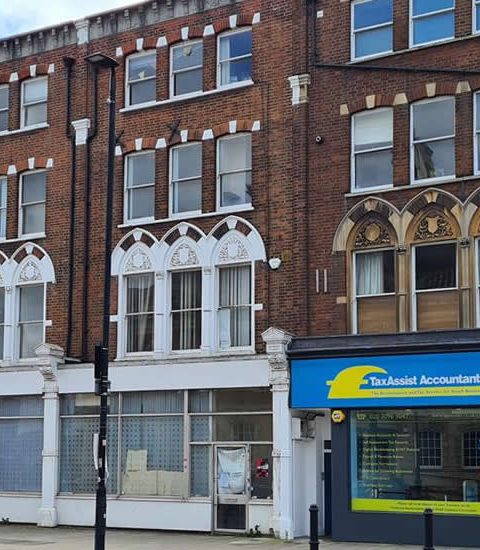If you have been concerned with property becoming less and less affordable, the difficulty in finding a home, or the risk of becoming homeless, you won’t be reassured to read that now even air can be bought for private use.
Phillip Arnold, an auction house based in London offering service for the sale of properties is committed to put under the hammer the airspace above 47 Northcote Road in Clapham Junction, with a starting price of £10,000 (and it could go anywhere above that amount).
The offering, comprising the airspace above two self-contained flats and a ground floor restaurant undergoing conversion into a café, is marketed as being sold with vacant possession (of course, because this is just air at the moment!). It is being sold with a 150 years lease (originally noted 125 years on the notice but subsequently altered).
The amount of airspace sold may allow building an additional 2 storeys atop the 4 existing floors if planning permission is granted.
The auction was made to happen on Wednesday 7th December but was delayed at the last minute, the freeholder having failed to serve the “correct notices” on the leaseholders of the flats below. Philip Arnold told us:
“It transpired that the freeholder had not submitted a section 5 notice on the leaseholders and as such the property could not be marketed. We are advised that they will now do that in the new year, so the airspace will be re-offered at some point in 2024.”
A Section 5 Notice is a legal document served on leaseholders by their landlord, informing them of the landlord’s intention to sell part of the property. In case of an auction, leaseholders have a period of time to decide if they want to make an offer to purchase the freehold themselves.

Airspace above properties belongs to the freeholder
Controversial developments based on new planning rights from 2020
In July 2020, the UK Government implemented changes to Permitted Development Rights (PDR) aimed at facilitating construction on top of current structures under specific conditions. Under the new set of rules, a project must meet a number of criteria in order to gain prior approval. But in a nutshell, a building of 3 storeys or more would be allowed to build up to two new storeys of flats, without full planning permission.
PDR are a set of rules that allow property owners to make certain changes to their buildings without having to apply for planning permission from the local authority.
In the case of Northcote Road, the building meets most of the criteria, but one of them raises doubt about the possibility of PDR, as it stipulates that the building must have been “constructed before 1st July 1948, or after 5th March 2018“, casting doubts on the possibility of applying for PDR.
It does not mean that the new owners won’t be able to apply for a two-storey structure on top of the existing building. It only means that in that case, they will have to go through the full planning process.
With the shortage of housing and the law providing specific rights to the property freeholder, some companies such as Upspace have seen opportunities and specialised in providing advice on residential airspace developments.
A precedent with the neighbouring building
The freeholder might have spotted an opportunity when both 43 and 45 Northcote Road received planning permission for full demolition and construction of a 5-storey building just before the local election lost by the Conservatives in March 2022 (p.a. 2021/5139). When finished, the property should provide 5 residential units (1 x 1-bed, 3 x 2-bed, and 1 x 3-bed units).


Considering the planning officer’s report, questions have been raised on the necessity of writing a 37 document for 5 floors and 5 residential units. It questions the effort necessary to deal with a 38 storey tower and 150 units, and the continuous issue of an under-staffed and stretched planning department with an important turnover in Wandsworth Council.
Nevertheless, the demolition and replacement of the building in Northcote Road, including the consideration of massing and density, was considered acceptable, and the officer considered that it wouldn’t cause harm to the surroundings.

It must be noted that during the planning application committee debate, Conservative councillor Dawson presented the objection of the local residents and Labour councillors raised concerns. However, eventually the planning permission was granted by a majority of committee members.
A lot of uncertainty remains
The possibility to use the airspace above the property depends on the sort of lease granted to the owner of the top floor. If they are responsible for the roof, you will need their permission for any additional structure. Philip Arnold explained:
“Sometimes the lease may say it owns the base of the roof. If it did, it doesn’t matter what planning you get, you’d never be able to build on it because the person who owns the top flat can turn round and say: ‘Sorry, that’s my roof.”
In the case of the property in Northcote Road, the freeholder owns the roof, and therefore this is not an issue for the new owner. However, it becomes an additional issue for the leaseholder of the top floor who won’t be able to make any roof extension that could prevent the rights of the “airspace” owner. In addition, it remains to be seen how the above space could be constructed without affecting the original top flat, whose value will be drastically diminished by the airspace sale. Apparently, it does not prevent Arnold from auctioning the space, although he knows about the potential issue and said:
“Whether that leaseholder gets much say in it, I’m not sure. With any planning application that’s made, I’m sure they can take that up with the local planning office. But whether they can get it stopped or not, that’s another question.”
Air space deals are often sold with planning consent attached. In this specific case, there is no existing planning permission, and there is no indication that one could be granted. However, Arnold thinks that the buyer will probably try to get planning permission and then sell it with a profit to a developer, rather than doing it themselves.
Due to the planning permission for a 5-storey building on the adjoining property, a refusal on the ground of massing and size is very unlikely. However, 43-45 Northcote Road went through a full planning application process to redevelop entirely the plot, which is not the case for number 47.
In addition, the Council could issue an “Article 4” direction that may remove some of the development rights. That is what they have done in the past to restrict use of PDR to convert offices into residential.
At the moment, selling airspace is still an anomaly in London. Two months ago, some airspace went up for auction in Russell Square but did not reach the asking price of £100,000. The space is going back under the hammer with Savills this Wednesday for a reduced price of £80,000.
In other words, it is likely to be just financial speculation. The only thing certain right now is that a lot of thin air is on the market to be sold!

















Interesting, thank you.
I am surprised by this paragraph though “In July 2020, the UK Government implemented changes to Permitted Development Rights (PDR) […] planning permission from the local authority.”
Does it mean that anyone living in a victorian house (ie built before 1948, and usually 3 stories already, esp if counting the loft) can add 2 more floors without PP?!
Therefore without consideration of height vs neighbouring houses etc?
That would surely be more appealing than basement conversions!
There are specific conditions, and usually it does not apply to Victorian houses as they have been built before 1948. You will see the list of conditions here in Part 20 Par. A1: https://www.legislation.gov.uk/uksi/2020/632/made
thanks!